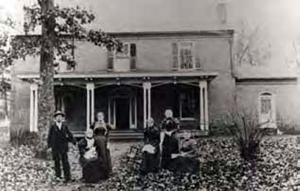Community Collaboration Saves Historic Sherrill House

Now and then a project comes along that proves open-minded and determined people can work together, even when their initial goals and expectations seem at odds. While they approach the project from different viewpoints and may disagree from time to time, their mutual desire to achieve a quality end result ensures the success of the endeavor. The recent rezoning and sale of the historic Kennedy-Baker-Walker-Sherrill House is one such story.
Located at 9320 Kingston Pike is the pre-Civil War Kennedy-Baker-Walker-Sherrill House, referred to more simply as the "Sherrill House." The Federal-style home was built around 1849, and members of these various families lived there for more than 100 years. After sitting empty for the last 20 years or so, the house and surrounding property were purchased by Kingston Pike, LLC in 2007 to develop the Sherrill Hill retail and residential complex.
As part of the purchasing process, Kingston Pike, LLC sought a rezoning to a "Planned Commercial" (PC) district. However, there were no immediate plans provided for how the historic Sherrill House could be incorporated into the redevelopment area. Given the community's 
The overlay was put in place with support from neighbors in the Seven Oaks subdivision and no opposition from the property owners. The overlay requires that proposals for changes to the exterior of the house or for demolition be reviewed by the Historic Zoning Commission. With approval of the overlay, the first step in ensuring the preservation of the house and its historic appearance came about.
Historic overlay regulations do not prohibit any uses?land use is governed by the underlying zoning on a property?but rather emphasize requirements to save historic buildings and preserve their form and shape.
Most historic buildings can be put to valuable new use, and market-savvy developers are finding imaginative ways to make their reuse profitable. Working with architects and site planners, developers can weave a historic fabric into new projects. Restoration plans for the Sherrill House are an example of the successful knitting together of an existing building with new development.
Preserving historic buildings?and thereby preserving community character?is easier when property owners are willing to raise the bar for quality development. Communities across the country are finding ways to permit creative reuse of older buildings and protect local historic character for future generations.
Ed McMahon, an Urban Land Institute expert on sustainable development, notes, "If every place was just like the other place, then there would be no reason to go anywhere." He believes that there are many ways to protect community character other than relying solely on government regulations such as historic district overlays.
Good preservation practices are not a single-minded effort to control land development decisions in order to meet preservation values. It is true that certain alterations may not be acceptable on a building because they would detract from the historic appearance of a significant landmark. But there are more cases in which a compromise can be found: a less important part of the building can be changed to meet the owners' needs and still save the valuable elements of the structure.
In the case of the Sherrill House, all parties recently agreed that the lot on which the house sits could be made smaller so that the property became more affordable for someone willing to restore the house and reuse it as office space. Also, the preservation proposal focuses on preserving the most important parts of the property while providing flexibility on how less important parts are treated. Being reasonable with expectations for preservation as well as for redevelopment helps the real estate market to adjust to the costs and opportunities that preservation creates.
Developers, preservationists, and the greater community all have a vested interest in saving and reusing historic buildings. For the success of all, each must be flexible in order to achieve preservation that supports profitable reuse. This type of cooperation and compromise, along with a visionary new buyer/developer, saved one of Knoxville's jewels, the historic Kennedy-Baker-Walker-Sherrill House.
Posted 02-06-2013, written by Kaye Graybeal

